Shadow Art Involving the Sky Darkenend Objects in Front of Sunlight
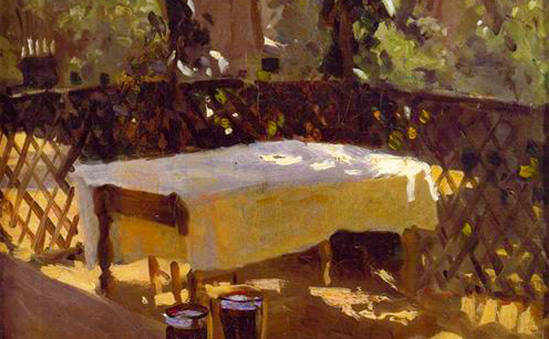
"A Painting is complete when it has a Shadow of a God"
Rembrandt van Rijn
I remember being taught at art higher that shadows weren't really present in paintings until the Renaissance period.
And you'd be forgiven for thinking when yous wait at some beginners work, that they were from Ancient Hellenic republic – they didn't use shadows either!
In live painting classes in the past, when I've mentioned the words 'bandage shadow', students concentration wains or worse, a look of rising panic crosses their faces as if they've been duped into a technical drawing class.
I'1000 not quite sure why bandage shadows seem so mysterious, elusive or disruptive. Shadows help to 'ground' an object and learning to accurately observe them, is the nigh effective fashion of making your paintings look convincing.
And merely by switching the name around it seems easier to digest.
Shadows bandage.
I want to keep it simple without the complications of multiple light sources or atmospheric perspective that occurs in vast landscapes, today I am going to focus on shadows cast outside, by sunlight.
Shadows cast past a tree, past a building, shadows cast by a chair or plant pot. The shadow that is falling onto the basis, or against a wall, or onto a tabular array.
Looking for Shadows
It tin can exist a actually good do to await through lord's day-dappled holiday photos, go outside and walk around your garden or if y'all live in the U.K. take advantage of the rare heatwave because there'll be a constant source of clear shadow shapes everywhere and purposely expect for subjects to paint where the shadows are the main focus of the paradigm.
This will assistance you to tune your eyes to look for interesting abstract shapes and patterns and begin to notice the interplay of shadows and the surfaces they autumn onto.
Merely it'due south not just a case of blocking in a black shadow on the ground, there are a few key things to discover that will make your cast shadows appear more believable.
#1.Shadow Shape
The starting time thing we need to look at is the shape of the shadow.
Beginners tend to focus on the chief subject they are trying to draw or paint, whereas artists will often await at the shapes around the subject (chosen negative space) and the shapes being cast past the subject.
Why?
Because it's easier to draw the abstract shapes of a shadow more than accurately than observing and trying to draw a familiar object (meet the 3 reasons why you can't describe)
#2. Shadow qualities
The two most mutual lighting atmospheric condition when painting outside are direct sunlight and a cloudy sky and both influence the qualities of the cast shadow edge.
- Straight sunlight gives us a hard light source that creates clearly visible shadows and produces a hard crisp edge to the cast shadows
- A cloudy sky gives us a soft calorie-free source which gives much subtler shadows with soft blurry edges.
And then yous'd recall difficult light source, difficult shadows.
Sometimes.
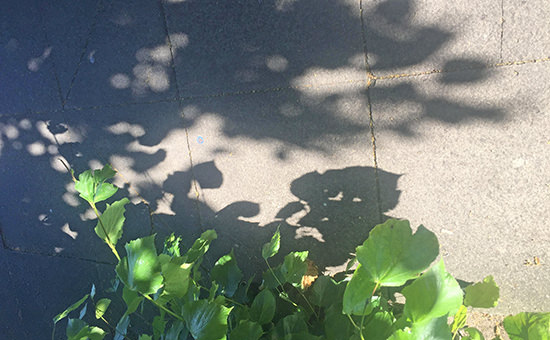
When y'all're painting a sunlit scene, the hardness of the shadows cast, alter when yous change the altitude between the subject and the surface its shadow is being cast onto.
In the photograph above there is a tree and a establish next to each other, both in direct hard sunlight and we're only concerned with the shadows cast onto the ground.
The plant which is closest to the ground has harder and sharper cast shadows than the shadows cast past the leaves of the tree that are farther abroad from the ground.
Notice how they're soft and blurry.
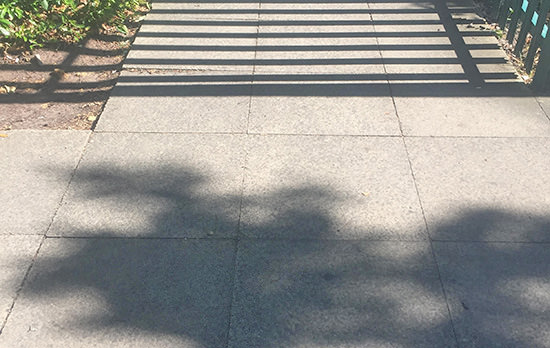
In this photo, again y'all tin can hands compare the crisp clear shadow shape at the base of the railings with the soft abstruse shadow shape of the tree leafage.
Aforementioned light.
Just a modify in altitude between the subject and the surface its shadow is being bandage onto.
"No shadow is black. Information technology always has a colour. Nature knows only colours … white and black are non colours."
Pierre-Auguste Renoir, Impressionist Painter
When I say the word shadow, what's is the first colour that springs to mind?
Normally, it'southward black or grey.
Only actually, cast shadows are the surface they autumn onto.
#iii. Colour in the cast shadows
The colour of the cast shadow is dependent on two main things:
- The color of the light source
- The colour of the surface the shadow is falling onto
The colour of the calorie-free source
Yous might accept heard artists talking about how a cool light source creates warm shadows and a warm light source creates cool shadows.
Now, this is technically true but I think it tin be a little misleading because personally when I think of absurd, I retrieve of a strong blue color and when I think of warm, I remember of a bright yellow or orange.
But when you're observing shadow colours the effect is much, much more subtle.
As a general rule of thumb, a sunny solar day volition be a warm xanthous calorie-free – producing a subtle, bluish/violet, cool grayness shadow.
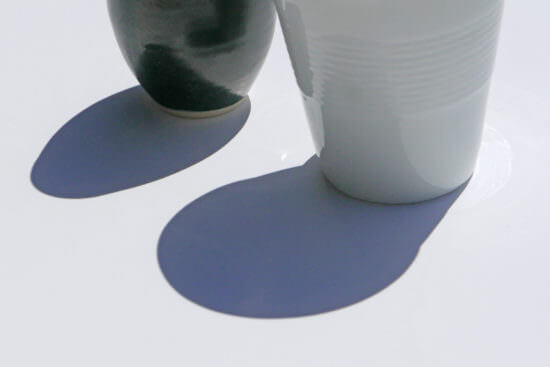
You have to look closely to endeavor and see the subtle temperature and color changes.
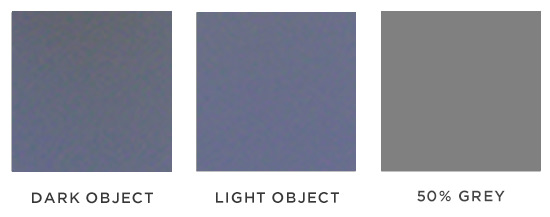
When nosotros isolate the colour of the cast shadows from the jugs to a higher place, you can see the purpley hue quite clearly compared to the neutral grayness paint swatch on the right.
The colour of the surface
The jugs take been photographed on a white surface, then the shadow colour is in direct response to the color of the calorie-free source.
Only when cast shadows autumn onto a coloured surface, you lot've got to take this into business relationship as well as the colour of the light source.
For example, on a sunny 24-hour interval, leaves casting a shadow onto grass would look unlike to leaves casting a shadow onto a dusty path.
Yous would have the same shadow color that would be purple/grey initially, (because of the warm sunlight) simply then it would be contradistinct by the general colour of the surface that the shadow is falling onto.

John Vocalizer Sargent, Two Wine Spectacles, 1875
In this plein air Sargent painting, you tin see how he has handled the different cast shadow colours depending on the local colour of the surfaces.
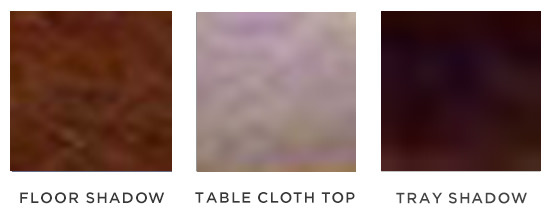
The area of the white tablecloth in shadow is a muted absurd pinkish/purple whereas the floor color is much warmer becasue of the yellow ochre ground beneath it.
Also, there is a small cast shadow nether the argent tray in the foreground that it close to a warm Burnt Umber due to the warmth of the wooden tabletop it is sabbatum upon.
There are a couple of small exceptions to these rules:
- When y'all have a translucent object and light tin laissez passer through it, like a stained drinking glass window, a thin leafage or oil in a glass bottle. Fifty-fifty in the photo of the translucent oils below, note how the colours at the far edge of all the shadows are all very shut in hue. This is because they are no longer existence altered by the translucency and the shadows are all falling on the same white surface.
- When you have a reflective object, like a white porcelain loving cup and the ambient light reflects off the surface and bounces into the cast shadow.
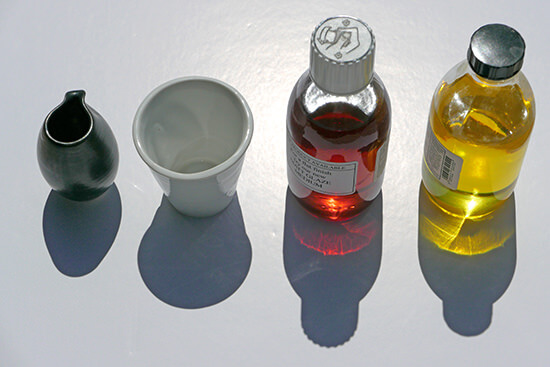
Does the subject area take any influence on the cast shadow colour?
It can do, but not as much as yous think.
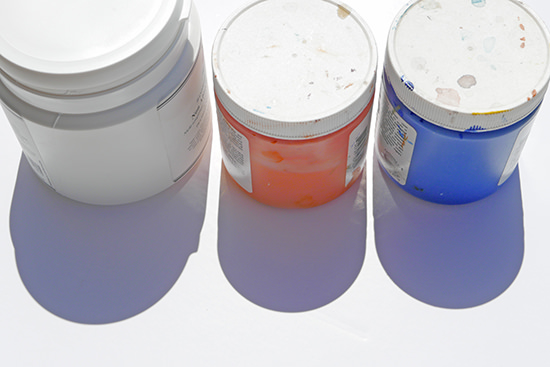
In this example, the color in the cast shadows reflected from these three paint pots is more than credible due to the shortness of the bandage shadow, the brightness of the colours of the paints and the white surface.
Mostly, the subject wouldn't accept such an obvious impact.
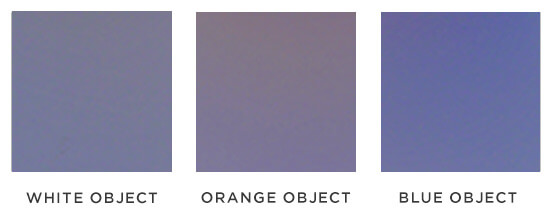
#four. Be Aware of the Tonal Value
So we've observed the shapes, the edge quality, the local colour of the surface and colour temperature of the light source.
Finally, we demand to observe the value of the shadows, how light or dark they are, too notice how they become lighter in value towards the edges.
And because you're outside, shadows are oft lighter than you call up due to the sunlight bouncing back into them.
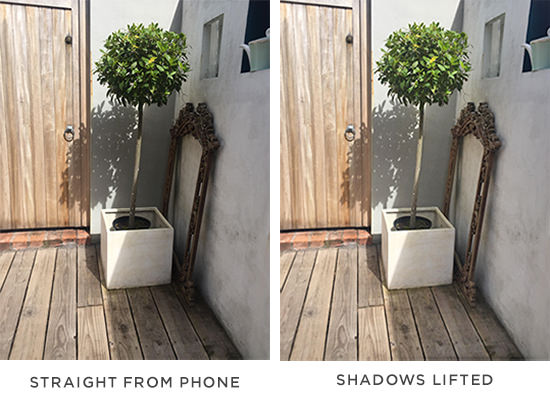 Reference photos taken with a phone or camera set to automatic, will virtually always over-darken your shadows.
Reference photos taken with a phone or camera set to automatic, will virtually always over-darken your shadows.
A simple remedy is to edit your photos with the congenital-in software by lifting up the shadows in the 'shadow' setting.
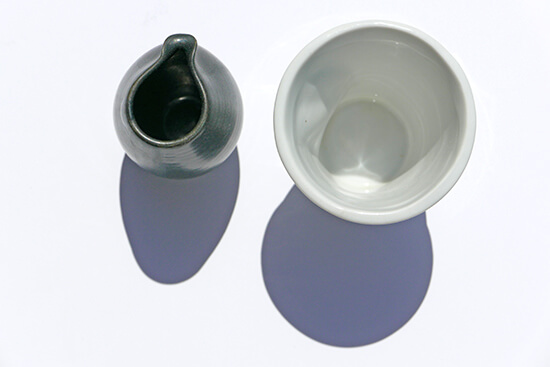
One more affair to recall is that because of the amount of bounced light outside, a white object volition reverberate more calorie-free into its shadows, you can see here how the cast shadow of the black jug is slightly darker.
Judging the tonal value accurately is a catchy ane!
But if yous can go information technology right, it will make your paintings really believable.
A expert tip is to offset with a mid-tone, value 5 of an globe color that's sympathetic to your scene.
Use this as a starting base of operations when blocking in your cast shadows. It won't be perfect, but it will give you a practiced tone to estimate other colours against and as the painting develops you tin can refine and add more color, darken or lighten.
Recap of the Steps
Step 1 – Detect the shape of the cast shadow. This is in straight response to the shape of the object casting the shadow and the shape of the surface the shadow falls onto.
Stride two – Observe the border quality of the shadow. How far is the shadow from the object you lot're painting? How much has is softened (even in hard sunlight)
Footstep iii – Detect the colour temperature of the light source. Warm light, cool but very muted shadows, cool low-cal warm only very muted shadows and keep information technology consistent. If you decide on a warm light and cool shadow composition stick to that throughout the painting.
Step 4 – Detect the local colour of the surface the cast shadow is falling onto.
Step five – Find the value of the shadow. If you're working from a reference image, bring upwardly the shadows.
p.s I'1000 working on a new however life projection ebook that will look more closely at mixing and matching the form shadows that make up the 2d part of the light and shadow puzzle!
You Might Also Similar:
- 10 minutes sketch of a bike – Drawing the cast shadow shape first
- Monet Impressionistic Demo
- How to choose a colour palette starter set
morseasereardscon.blogspot.com
Source: https://willkempartschool.com/the-secret-to-painting-realistic-shadows-in-sunlight/
0 Response to "Shadow Art Involving the Sky Darkenend Objects in Front of Sunlight"
Postar um comentário